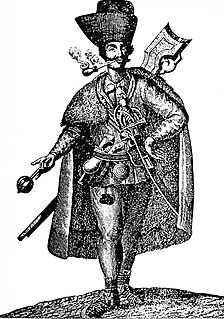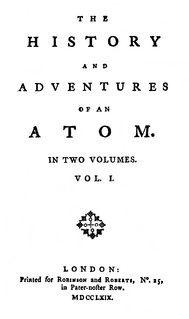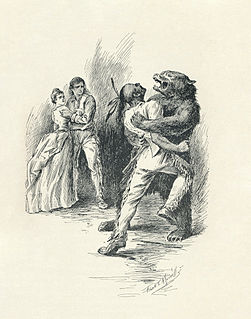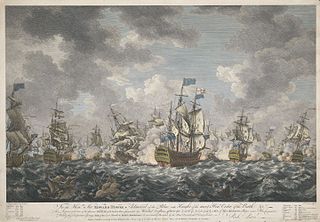 W
WThe Seven Years' War (1756–1763) is widely considered to be the first global conflict in history, and was a struggle for world supremacy between Great Britain and France. In Europe, the conflict arose from issues left unresolved by the War of the Austrian Succession (1740–1748), with Prussia seeking greater dominance. Long-standing colonial rivalries pitting Britain against France and Spain in North America and the Caribbean islands were fought on a grand scale with consequential results. In Europe, the war broke out over territorial disputes between Prussia and Austria, which wanted to regain Silesia after it was captured by Prussia in the previous war. Britain, France and Spain fought both in Europe and overseas with land-based armies and naval forces, while Prussia sought territorial expansion in Europe and consolidation of its power.
 W
WThe Anglo-Prussian Alliance was a military alliance created by the Westminster Convention between Great Britain and Prussia that lasted formally between 1756 and 1762, during the Seven Years' War. The alliance allowed Britain to concentrate most of its efforts against the colonial possessions of the French-led coalition while Prussia was bearing the brunt of the fighting in Europe. It ended in the final months of the conflict, but strong ties between both kingdoms remained.
 W
WThe Anglo–Spanish War was a military conflict fought between Britain and Spain as part of the Seven Years' War. It lasted from January 1762 until February 1763 when the Treaty of Paris brought it to an end.
 W
WGreat Britain was one of the major participants in the Seven Years' War, which in fact lasted nine years, between 1754 and 1763. British involvement in the conflict began in 1754 in what became known as the French and Indian War. Warfare in the European theater involving countries other than Britain and France commenced in 1756. Britain emerged from the war as the world's leading colonial power, having gained all of New France in North America, ending France's role as a colonial power there. Following Spain's entry in the war in alliance with France in the third Family Compact, Britain captured the major Spanish ports of Havana, Cuba and Manila, in the Philippines in 1762, and agreed to return them in exchange for Florida, previously controlled by Spain. The Treaty of Paris in 1763 formally ended the conflict and Britain established itself as the world's pre-eminent naval power.
 W
WThe siege of Havana was a successful British siege against Spanish-ruled Havana that lasted from March to August 1762, as part of the Seven Years' War. After Spain abandoned its former policy of neutrality by signing the family compact with France, resulting in a British declaration of war on Spain in January 1762, the British government decided to mount an attack on the important Spanish fortress and naval base of Havana, with the intention of weakening the Spanish presence in the Caribbean and improving the security of its own North American colonies. A strong British naval force consisting of squadrons from Britain and the West Indies, and the military force of British and American troops it convoyed, were able to approach Havana from a direction that neither the Spanish governor nor the Admiral expected and were able to trap the Spanish fleet in the Havana harbour and land its troops with relatively little resistance.
 W
WThe British occupation of Manila was an episode in colonial history of the Philippines when the Kingdom of Great Britain occupied the Spanish colonial capital of Manila and the nearby port of Cavite for twenty months from 1762 to 1764. The occupation was an extension of the larger Seven Years' War between Britain and France, which Spain had recently entered on the side of the French.
 W
WThe Carnatic Wars were a series of military conflicts in the middle of the 18th century in India's coastal Carnatic region, a dependency of Hyderabad State, India. Three Carnatic Wars were fought between 1746 and 1763.
 W
WThe Conference at the Highest Court was the highest state institution of the Russian Empire. It was established in 1756 on the initiative of Chancellor Alexey Bestuzhev-Ryumin. It was abolished in 1762. Formally considered an advisory body, but in most cases acted independently on behalf of the empress. The conference used legislative power, gave instructions and orders to the Senate, the Synod, the colleges and other central institutions of the empire.
 W
WThe Diplomatic Revolution of 1756 was the reversal of longstanding alliances in Europe between the War of the Austrian Succession and the Seven Years' War. Austria went from an ally of Britain to an ally of France, while Prussia became an ally of Britain. The most influential diplomat involved was an Austrian statesman, Wenzel Anton von Kaunitz.
 W
WThe Expulsion of the Acadians, also known as the Great Upheaval, the Great Expulsion, the Great Deportation, and the Deportation of the Acadians, was the forced removal by the British of the Acadian people from the present-day Canadian Maritime provinces of Nova Scotia, New Brunswick, and Prince Edward Island, and the present-day U.S. state of Maine — parts of an area historically known as Acadia, causing the death of thousands of people. The Expulsion (1755–1764) occurred during the French and Indian War and was part of the British military campaign against New France. The British first deported Acadians to the Thirteen Colonies, and after 1758, transported additional Acadians to Britain and France. In all, of the 14,100 Acadians in the region, approximately 11,500 were deported. A census of 1764 indicates that 2,600 Acadians remained in the colony having eluded capture.
 W
WFrance was one of the leading participants in the Seven Years' War which lasted between 1756 and 1763. France entered the war with the hope of achieving a lasting victory against Prussia, Britain and their German allies and with the hope of expanding its colonial possessions.(1)
 W
WFree Ilocos was a state in Northern Luzon which was declared independent by revolutionary Diego Silang in December 14, 1762. Villa Fernandina was designated as the capital of the independent state. Diego Silang led a revolt to liberate Ilocos from Spanish colonial rule taking advantage of the Spanish colonial government's momentary loss due to the British occupation of Manila. Diego Silang accepted an offer of protection and friendship sent by the British Governor of Manila, Dawsonne Drake, on September 24, 1762. Free Ilocos was effectively disestablished upon Diego Silang's assassination in 1763.
 W
WThe French and Indian War (1754–1763) was a theater of the Seven Years' War, which pitted the North American colonies of the British Empire against those of the French, each side being supported by various Native American tribes. At the start of the war, the French colonies had a population of roughly 60,000 settlers, compared with 2 million in the British colonies. The outnumbered French particularly depended on the natives.
 W
WThe Capture of Gorée occurred in December 1758 when a British naval expedition led by Augustus Keppel against the French island of Gorée off the coast of Senegal during the Seven Years' War.
 W
WGreat Britain was one of the major participants in the Seven Years' War, which in fact lasted nine years, between 1754 and 1763. British involvement in the conflict began in 1754 in what became known as the French and Indian War. Warfare in the European theater involving countries other than Britain and France commenced in 1756. Britain emerged from the war as the world's leading colonial power, having gained all of New France in North America, ending France's role as a colonial power there. Following Spain's entry in the war in alliance with France in the third Family Compact, Britain captured the major Spanish ports of Havana, Cuba and Manila, in the Philippines in 1762, and agreed to return them in exchange for Florida, previously controlled by Spain. The Treaty of Paris in 1763 formally ended the conflict and Britain established itself as the world's pre-eminent naval power.
 W
WGrenz infantry or Grenzers or Granichary were light infantry troops who came from the Military Frontier in the Habsburg Monarchy. This borderland formed a buffer zone between Christian Europe and the Ottoman Empire, and the troops were originally raised to defend their homelands against the Ottoman Turks. When there was no danger of war against the Ottomans, the Grenzer regiments were employed by the Habsburgs in other theatres of war, although one battalion of each regiment would always remain guarding the border.
 W
WThe History and Adventures of an Atom is a novel by Tobias Smollett, first published in 1769. The novel savagely satirises English politics during the Seven Years' War.
 W
W"How Stands the Glass Around", also referred to as "General Wolfe's Song", is an English folk song. The lyrics express the suffering of soldiers, wherefore the song was primarily popular among people serving in the military. It deals with the helplessness experienced during war and the boldness demanded in the military, but also about reducing fear and pain by consuming alcohol. One paper suggests that it was the favourite song of Alexander Hamilton.
 W
WInternational relations from 1648 to 1814 covers the major interactions of the nations of Europe, as well as the other continents, with emphasis on diplomacy, warfare, migration, and cultural interactions, from the Peace of Westphalia to the Congress of Vienna. It is followed by International relations of the Great Powers (1814–1919).
 W
WThe Last of the Mohicans: A Narrative of 1757 is a historical romance written by James Fenimore Cooper in 1826.
 W
WA British invasion of Martinique took place in January 1759 when a large amphibious force under Peregrine Hopson landed on the French-held island of Martinique and unsuccessfully tried to capture it during the Seven Years' War. Cannon fire from the British fleet was ineffective against the fortress at Fort-Royal due to its location high on the cliffs, and there were no suitable landing places nearby. Unknown to the British commanders, French governor Francis de Beauharnais had not been resupplied for some months, and even a brief siege would have led to the fort's capitulation. However, Moore and Hopson decided instead to investigate the possibility of attacking Martinique's main commercial port, Saint-Pierre. After a desultory naval bombardment on 19 January that again had little effect on the port's defences, they withdrew, and decided instead to attack Guadeloupe, home to a significant body of French privateers. The expedition was successful at Guadeloupe, which surrendered to them in May 1759. In 1762 a British force captured Martinique.
 W
WThe British expedition against Martinique was a military action that took place in January and February 1762. It was part of the Seven Years' War.
 W
WThe Miracle of the House of Brandenburg is the name given by Frederick II of Prussia to the failure of Russia and Austria to follow up their victory over him at the Battle of Kunersdorf on 12 August 1759 during the Seven Years' War.
 W
WÎle aux Noix is an island on the Richelieu River in Quebec, close to Lake Champlain. The island is the site of Fort Lennox National Historic Site of Canada. Politically, it is part of Saint-Paul-de-l'Île-aux-Noix.
 W
WAdolf Friedrich von Olthof was a Swedish Pomeranian councilor, and patron of the arts.
 W
WA French invasion of Great Britain was planned to take place in 1759 during the Seven Years' War, but due to various factors was never launched. The French planned to land 100,000 French soldiers in Britain to end British involvement in the war. The invasion was one of several failed French attempts during the 18th century to invade Britain.
 W
WThe Pomeranian War was a theatre of the Seven Years' War. The term is used to describe the fighting between Sweden and Prussia between 1757 and 1762 in Swedish Pomerania, Prussian Pomerania, northern Brandenburg and eastern Mecklenburg-Schwerin.
 W
WThe Sassnitz campaign was a military campaign between Swedish and Prussian forces from 1757 to 1762, during the Seven Years' War. It took place around Sassnitz, in Pomerania. At the end of the campaign Sweden remained in control of the area.
 W
WThe siege of Fort St Philip took place in 1756 during the Seven Years' War.
 W
WThe Silesian Wars were three wars fought in the mid-18th century between Prussia and Habsburg Austria for control of the Central European region of Silesia. The First (1740–1742) and Second (1744–1745) Silesian Wars formed parts of the wider War of the Austrian Succession, in which Prussia was a member of a coalition seeking territorial gain at Austria's expense. The Third Silesian War (1756–1763) was a theatre of the global Seven Years' War, in which Austria in turn led a coalition of powers aiming to seize Prussian territory.
 W
WThe Spanish invasion of Portugal between 5 May and 24 November 1762 was a military episode in the wider Seven Years' War in which Spain and France were defeated by the Anglo-Portuguese Alliance with broad popular resistance. It involved at first the forces of Spain and Portugal until France and Great Britain intervened in the conflict on the side of their respective allies. The war was also strongly marked by guerrilla warfare in the mountainous country, which cut off supplies from Spain, and a hostile peasantry, which enforced a scorched earth policy as the invading armies approached that left the invaders starving and short of military supplies and forced them to retreat with heavy losses, mostly from starvation, disease, and desertion.
 W
WThe Carnatic Wars were a series of military conflicts in the middle of the 18th century in India's coastal Carnatic region, a dependency of Hyderabad State, India. Three Carnatic Wars were fought between 1746 and 1763.
 W
WThe Third Silesian War was a war between Prussia and Austria that lasted from 1756 to 1763 and confirmed Prussia's control of the region of Silesia. The war was fought mainly in Silesia, Bohemia and Upper Saxony and formed one theatre of the Seven Years' War. It was the last of three Silesian Wars fought between Frederick the Great's Prussia and Maria Theresa's Austria in the mid-18th century, all three of which ended in Prussian control of Silesia.